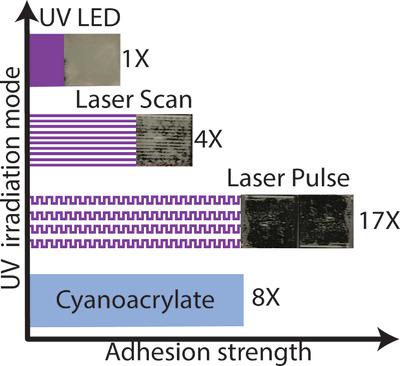当前位置:
X-MOL 学术
›
Macromol. Mater. Eng.
›
论文详情
Our official English website, www.x-mol.net, welcomes your feedback! (Note: you will need to create a separate account there.)
Pulsed Laser Activation of Carbene Bioadhesive Boosts Bonding Strength
Macromolecular Materials and Engineering ( IF 3.9 ) Pub Date : 2019-08-30 , DOI: 10.1002/mame.201900230 Ankur H. Shah 1 , Pilla Kartheek 2 , Prasanna Gandhi 2, 3 , Krishna Jonnalagadda 2 , Terry W. J. Steele 1
Macromolecular Materials and Engineering ( IF 3.9 ) Pub Date : 2019-08-30 , DOI: 10.1002/mame.201900230 Ankur H. Shah 1 , Pilla Kartheek 2 , Prasanna Gandhi 2, 3 , Krishna Jonnalagadda 2 , Terry W. J. Steele 1
Affiliation

|
Light‐activated tissue adhesives are limited to low light doses (50 J) and intensities (<1 W cm−2) due to photo‐to‐thermal heat generation. Low intensities have the disadvantage of limited penetration depths with retarded crosslinking kinetics, which impairs carbene‐based crosslinking strategies that compete with nitrogen evolution and gas nucleation. These limitations are circumvented by a trade‐off between high‐intensity activation while reducing the exposure surface area. Continuous or pulsed activation by line scanning the carbene precursor adhesive allows curing a higher surface area/volume ratio while preventing localized heat generation. By optimizing irradiation with a pulsed laser scan, the adhesion strength is improved by 17‐fold over ultraviolet A (UVA) light emitting diodes (LEDs) and is on par with bioadhesive gold standard of topical cyanoacrylates. Overall, this improved method of photo‐activation applies to other industrial and clinical photocuring adhesives where limits on UVA dose constrain exposure intensities.
中文翻译:

脉冲激光活化碳生物粘合剂可提高粘结强度
光活化的组织粘合剂仅限于低光剂量(50 J)和强度(<1 W cm -2)由于产生了光热能。低强度的缺点是渗透深度有限,交联动力学受阻,从而削弱了与碳氮和气体成核竞争的基于卡宾的交联策略。这些限制可以通过在高强度激活与减少暴露表面积之间进行权衡来避免。通过线扫描卡宾前体粘合剂进行的连续或脉冲活化可以固化更高的表面积/体积比,同时防止局部发热。通过使用脉冲激光扫描优化辐照,其粘合强度比紫外线A(UVA)发光二极管(LED)提高了17倍,与局部氰基丙烯酸酯的生物粘合金标准相当。全面的,
更新日期:2019-11-08
中文翻译:

脉冲激光活化碳生物粘合剂可提高粘结强度
光活化的组织粘合剂仅限于低光剂量(50 J)和强度(<1 W cm -2)由于产生了光热能。低强度的缺点是渗透深度有限,交联动力学受阻,从而削弱了与碳氮和气体成核竞争的基于卡宾的交联策略。这些限制可以通过在高强度激活与减少暴露表面积之间进行权衡来避免。通过线扫描卡宾前体粘合剂进行的连续或脉冲活化可以固化更高的表面积/体积比,同时防止局部发热。通过使用脉冲激光扫描优化辐照,其粘合强度比紫外线A(UVA)发光二极管(LED)提高了17倍,与局部氰基丙烯酸酯的生物粘合金标准相当。全面的,



























 京公网安备 11010802027423号
京公网安备 11010802027423号